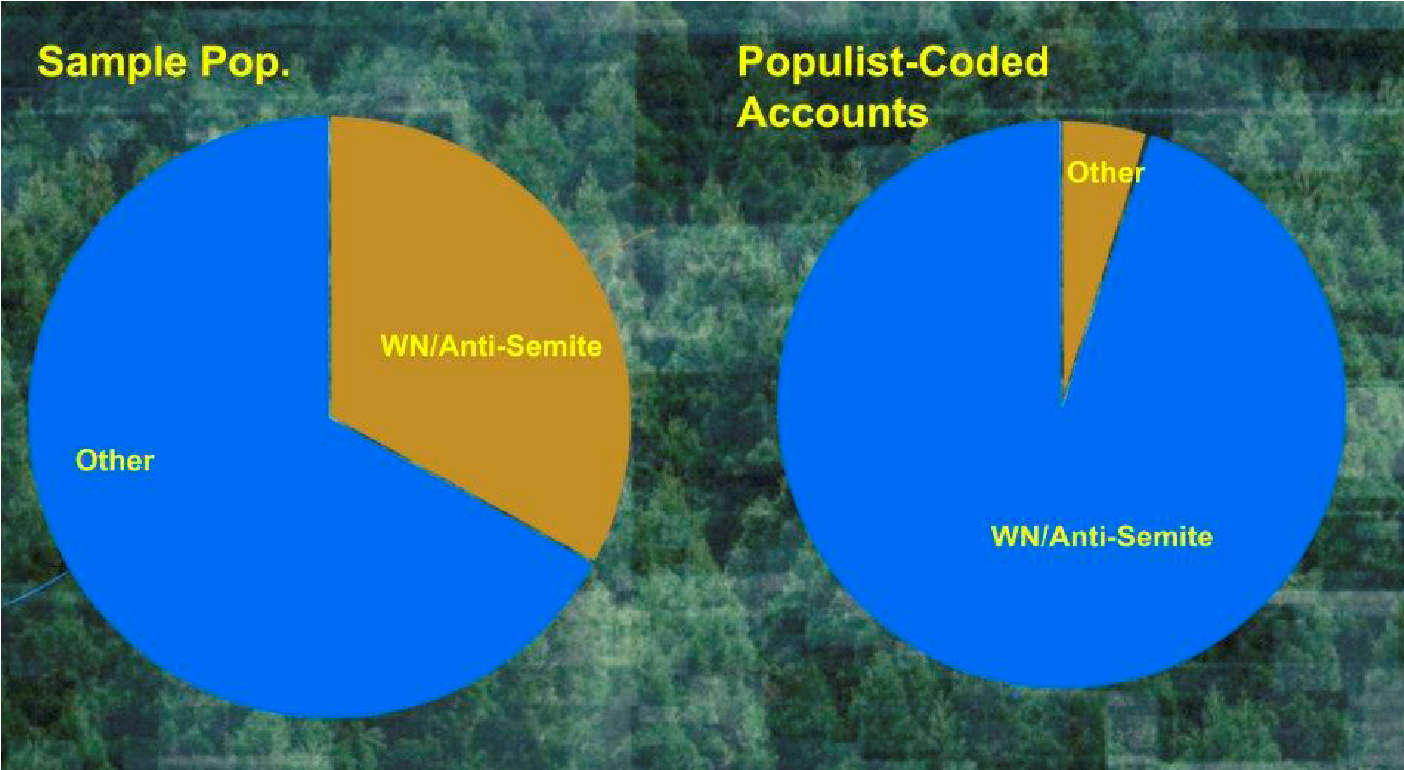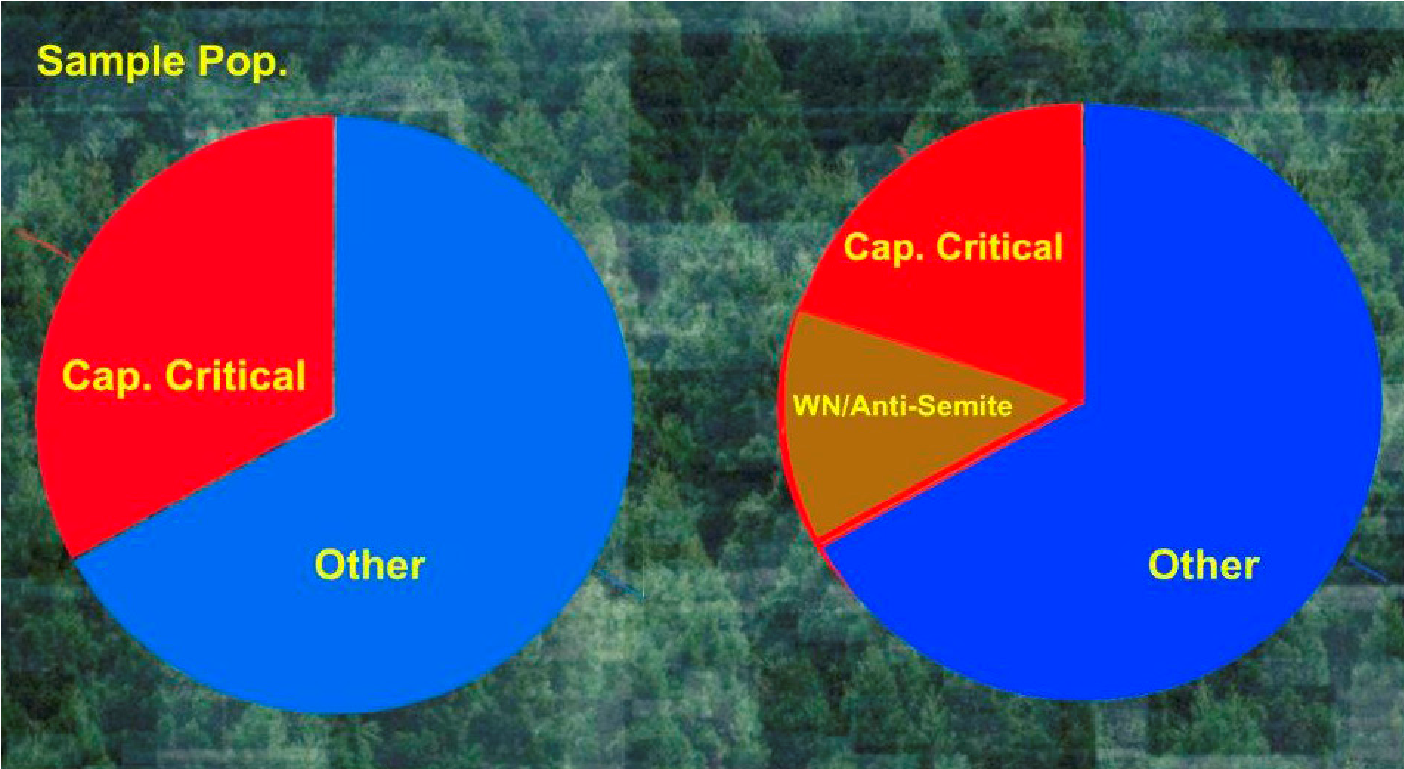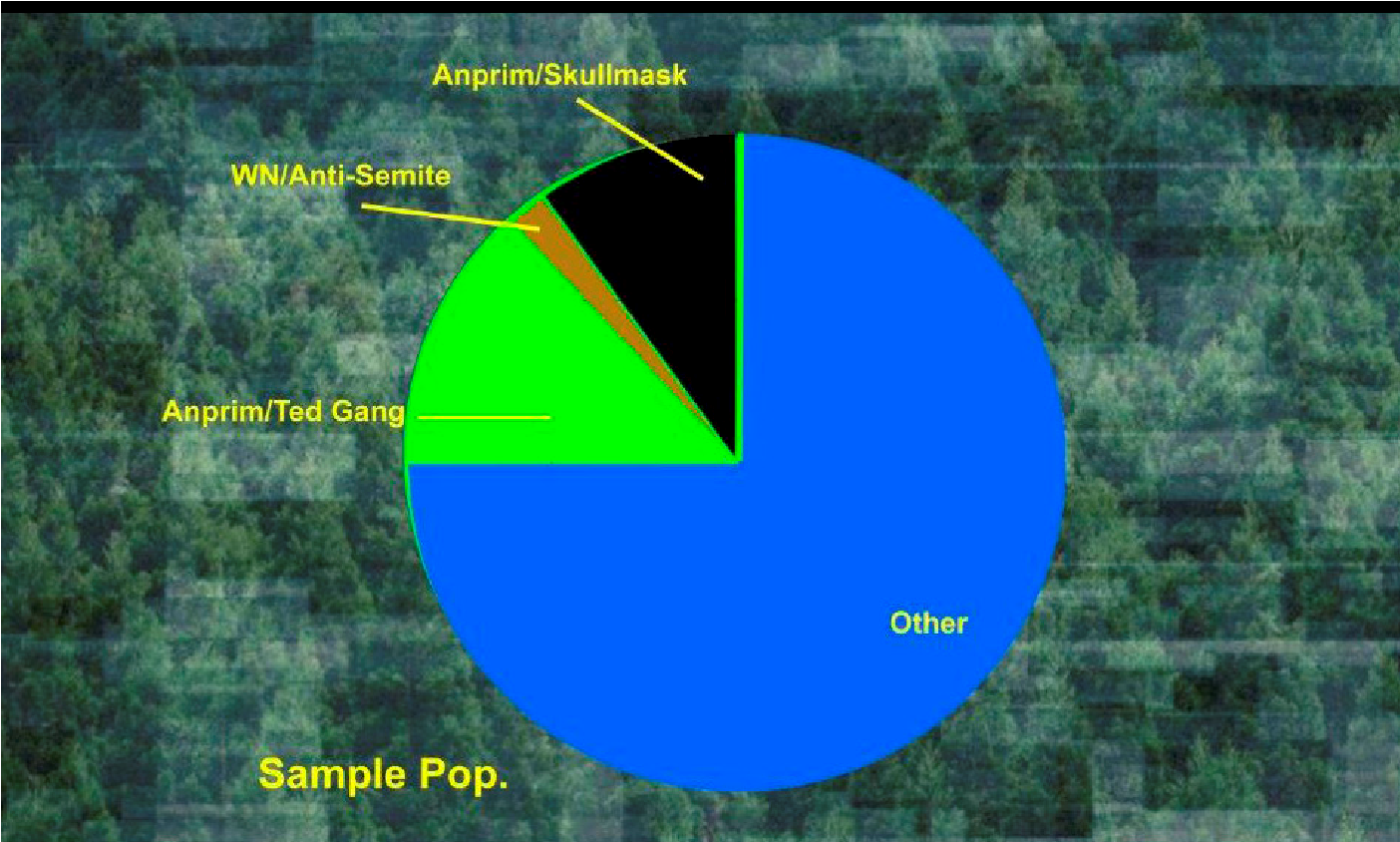Brian Hughes
“Pine Tree Twitter” and the Shifting Ideological Foundations of Eco-Extremism


Does environmentalism – and by implication its radical core and extremist fringes – “belong” to the political left or to the right? This is a question whose answer is both historically and culturally contingent. Past instantiations of environmental politics have been claimed by both left and right. Today, as climate shocks resound more loudly with each passing day, we are on the cusp of a new revolution in the political orientation of environmentalist radicalism. The far right has rediscovered ecology. Eco-fascism is emerging at both the highest levels of state and the lowest reaches of the political underworld. However, this may be only part of a much larger, more ideologically complex, emerging extremist threat. The climate crisis—and the crisis of global financial capitalism from which it is inextricable—may yet be driving a realignment of extremist environmental politics. An exploratory analysis of radical environmentalist discourse on the Twitter platform reveals the emergence of an ecological extremism that confounds contemporary understandings of left, right, authoritarian and liberal. If this represents the future of eco-extremism, it may be necessary for researchers and practitioners to reorient the frameworks that guide their assessment of emerging risks.
The history of conservation, and of connections between environmentalism and extremist ideology, demonstrates that the protection and restoration of wild spaces (or at least their social imaginary) has been fluid across left and right. Fascism, “was ecology-minded long before socialism” (Coren, 1995, p. 45). German National Socialism, for example, incorporated existing threads of German conservationism into the Nazi project, in “a volatile admixture of primeval Teutonic nature mysticism, pseudo-scientific ecology, irrationalist anti-humanism, and a mythology of racial salvation through a return to the land” (Biehl, 1995, p. 14).
In the United States (where my research is focused), mid-century environmental issues enjoyed a mainstream bipartisan consensus (Allitt, 2014) until the 1980s, when the American conservative movement abandoned ecology in response to “the Republican Party’s increasing ties with resource-based industries” (Farber, 2017, p. 1009). Roughly contemporaneous is the emergence of European left-liberal Green parties with their “ecologically oriented disposition…and a close link to the new social movements of the 1960s and 1970s” (Burchell, 2002, p. 1).
In the final decades of the 20th Century, environmental radicalism in the Anglosphere and much of the West belonged to the far left. The Radical Environmentalist and Animal Rights (REAR) movement was epitomized by groups like the Animal Liberation Front (ALF), Earth Liberation Front (ELF), Greenpeace, Earth First!, and others. These groups framed their activities – both legal and criminal – through a politics of liberation (Hirsch-Hoefler & Mudde, 2014), which was “contextualized within larger socio-political, radical-left ideologies and ambitions, typically Marxism, communism, anarchism, or anti-industrial capitalism” (Pieslak, 2015, p. 151). This “red and black” eco-radicalism came under severe scrutiny at the height of the Global War on Terror, and in the United States was aggressively pursued and prosecuted under post 9/11 terrorism statutes (Federal Bureau of Investigation (FBI), 2006).
With the far-left REAR movement broken apart by federal prosecution, and with environmental shocks associated with global climate change, a new, far right environmental extremism is emerging today. In March 2019, the Christchurch Mosque shooter’s manifesto proclaimed its author an “ecofascist” (Tarrant, 2019, p. 17) and announced that “there is no nationalism without environmentalism…There is no traditionalism without environmentalism” (2019, p. 38). Groups such as Atomwaffen Division, The Base, the English group National Action, and other white supremacist militia groups, ”frame the urban and industrial aspects of modernity as an attack on the white race, and present Jews and immigrants as parasites and invaders” (Lawrence, 2019). Their communication materials make frequent references to a dreamed-of societal apocalypse, brought on in part through environmental degradation. In the event of such a collapse, these groups aim to seize power and institute their own harsh visions of social order and racial purity wherein “a sacred mission to defend one’s spiritual home…[turns] mass murderers into martyrs for a “higher” purpose” (ibid). In only a few years, these examples have been marked by violence (Miller-Idriss, 2019) and at least five definitively linked murders in the U.S. alone (Ware, 2019). Clearly, one should take seriously the birth of this new far right eco-extremism. Groups such as these represent an underworld of eco-fascism. Yet there is a parallel environmentalism of the far right emerging within the right-populist wave that still convulses Europe, the U.S. and Australia. Climate change denialism is increasingly untenable to all but the most motivated fantasists. Right-wing movements’ rhetoric and policy is evolving in response, and has begun to link the looming specter of environmental shocks to more perennial far-right concerns. For example, “in many European countries, where younger activists within far-right parties – those who will have to live with the worsening effects of climate change – are agitating to cut into green parties’ monopoly of the issue by tying it to their anti-migrant appeals” (Abegglen, 2019). The European refugee crisis and U.S. immigration policy (both of which redound partly to climate issues) have evoked in the far-right political imagination “a new socio-technical machine, a kind of Fortress Eco-Nationalism…in which either the wealthy or the entire population of the wealthy states will laager up behind militarized seawalls and sea-lanes…[and] a militarized approach to socio-economic transformation” (Ajl, 2019).

The growing salience of eco-fascism as a mainstream political potential should not be divorced from the clandestine terror of groups like National Action and Atomwaffen. As climate crisis veers closer to climate catastrophe, and eco-authoritarianism moves from the realm of the potential to that of the real, the two movements may enjoy a mutually enhancing relationship. As Belew notes, “vigilantism should be understood as violence that serve[s] to constitute, shore up, and enforce systemic power” (2018, p. 108). On the one hand, extralegal militias routinely execute violence on behalf of sympathetic states. On the other, the very presence of guerilla eco-fascist groups renders state eco-fascism more plausible, and perhaps desirable to some, as an ordered alternative.
However, the appearance of these deadly, environmentally aligned groups, is only one facet of a far more diverse and complex emerging eco-extremism. While at the moment, far-right environmentalism is ascendant, there is good reason to anticipate that this will not always be the case. As suggested in the study below, the very foundations of future eco-extremism could upset the today’s accepted orientations of Left and Right, liberal authoritarian.
Pine Tree Twitter and a Breakdown in Ideological Consistency
The following qualitative analysis of socalled Pine Tree Twitter was undertaken in the summer of 2019, in order to understand emerging discourses of 21st Century eco-radicalism. Pine Tree Twitter is a social media discourse of ecofascists, neo-luddites, radical accelerationists, decelerationists, and more (Hanrahan, 2018). These individuals often identify themselves to one another by placing a Pine Tree emoji in their names or bios.
In researching these groups’ shared communication, this study uncovered a trove of idiosyncratic ideologies and microcultures. Those idiosyncrasies suggest that the emerging foundations of eco-radicalism may not easily map onto our conventional understandings of the political left and right.
It must be noted that the use of Twitter here is merely a sampling strategy. There is no reason to think that Pine Tree Twitter represents the totality of emerging eco-extremism. Indeed, the most troubling far-right apocalypticism— such as that of Atomwaffen, National Action, the Base, and others—takes place today on encrypted messaging applications (Owen, 2019). But neither is Pine Tree Twitter an insignificant space in eco-radical discourse. While today’s vanguard of eco-fascism may best be observed on platforms such as Telegram, Pine Tree Twitter represents the possible bud of a future eco-radical growth—one which has yet to emerge.
To obtain this study’s sample, a Twitter search was conducted for accounts with the hashtag #PineTreeGang in their bios. This method resulted in two seed accounts, which were used as the core of a two-round snowball sample. The profiles of every follower and followee of these seed accounts were analyzed. Any accounts displaying a pine tree emoji in their name or bio were added to a list of possible Pine Tree Twitter accounts. This process was then repeated for the followers and followees of every account obtained in the first snowball round. Finally, every account was scrutinized for environmental and politically radical content, so as to eliminate false positives. In the end, this method obtained 985 individually confirmed Pine Tree Twitter accounts. 100 of these were randomly sampled for examination and preliminary coding development. These are the findings of that pilot study.


For the purposes of coding, accounts were analyzed to identify salient ideological tendencies and cultural signifiers. It was noted when accounts expressed sentiments reflecting the following ideological tendencies: (1) White supremacism or ethno-nationalism; (2) Anti-Semitism; (3) Support for far-right populist politics; (4) Criticism of capitalism; (5) Social Progressivism; (6) Anti-Interventionism or anti-Imperialism. Most accounts sampled exhibited more than one ideological tendency.
A collection of micro-cultures also seemed to exist within Pine Tree Twitter. These were coded according to the following categories: (1) “Skullmasks,” that is, accounts espousing the visual grammar or rhetoric of clandestine eco-fascist groups; (2) “Ted Gang,” that is, accounts that idolize the Unabomber Ted Kaczynski; (3) Pagan, heathen, or occultist; (4) Christian Orthodoxy, such as Traditionalist Catholicism or Eastern Rite; (5) “channers,” that is, accounts making use of the argot and iconography of the 4chan and 8chan image boards. Many accounts identified themselves with more than one such micro-culture.

Using those ideological and cultural codes, these accounts were then coded according to political scientist Corey Robin’s theory of ideological difference between the politics of Left and Right. In his book The Reactionary Mind, Robin states that the key difference between the political Left and Right is in their treatment of (in his words) regimes of power. The Right, he says, is concerned with preserving and expanding the private regime of power. It will “cede the field of the public, if [it] must, but stand fast in private. [It will] allow men and women to become democratic citizens of the state; [but] make sure they remain feudal subjects in the family, the factory, the field. The priority of conservative political argument has been the maintenance of private regimes of power” (Robin, 2017, p. 15). This is what unites libertarians, fascists, and monarchists alike, the belief that power is to be sorted out among an elite through mechanisms of the market, heredity, strength of will, or some other method. The Left, by contrast, is characterized by its belief in a public regime of power, “not a sacrifice of freedom for the sake of equality, but an extension of freedom from the few to the many” (Robin, 2017, p. 9). This is the common thread linking pluralist democracy, anarcho-syndicalism, and the theoretical telos of Marx: the conviction that power is to be distributed evenly and exercised in the interest of human emancipation. In some cases, of course, that end is seen to justify any necessary means.

This binary is complicated and perhaps stretched to the breaking point when applied to Pine Tree Twitter. The following findings indicate how.
Findings
A significant percentage of sampled accounts only expressed run-of-the-mill far-right positions. Roughly one-third of the sample displayed strong white supremacist, ethno-nationalist or anti-semitic sentiments; generally, if an account expressed one of those positions, it also expressed the other two. Many of this far right segment also expressed support for populist right politics, and conversely most supporters of populist projects also expressed white supremacist, ethno-nationalist, or antisemitic ideology. Interestingly, very few of these racist and/or populist accounts expressed much interest in ecology. They made few, if any, comments on environmental issues, and rarely shared imagery of wild nature (a common practice across the rest of Pine Tree Twitter). The absence of ecological content in these far right accounts might not be shocking. There is a “fashion cycle” to the online far-right. It’s a means of signaling status in a digital subculture that holds “normies” in contempt (Nagle, 2017). And Pine Tree seemed to be the preferred digital fashion statement of 2018–19.
Interestingly, however, these otherwise run-of-the-mill far right accounts were distributed evenly across Robin’s division of power regimes. That is, a roughly equal number of white supremacist, ethno-nationalist, antisemitic, and populist accounts expressed preference for the freedom and equality of the public regime of power as for the hierarchy and micro-feudalism of the private regime of power. Accounts that exhibited interest and support for populist political projects tended to reflect Cas Mudde’s definition of populism as “a thin-centered ideology that considers society to be ultimately separated into two homogenous and antagonistic groups: ‘the pure people’ and ‘the corrupt elite,’ and argues that politics should be an expression of the volonté générale (general will) of the people” (Mudde, 2015). However, among Pine Tree Twitter accounts, these populist tendencies tended not to consolidate this desire in the figure of a strong leader (e.g. Trump, Orban, etc.).


Similarly, accounts expressing tendencies toward white supremacist collectivism were coded as preferring the public regime of power. In this case, while the public is defined racially, individual interest and unitary authority are otherwise subordinate to the racial collective. This contrasts with the classic fascist preference for a strong, authoritarian, executive (Paxton, 2004). While this racist, antisemitic, populist one-third of Pine Tree Twitter demonstrates questionable ecological bona fides, it nevertheless betrays fundamental preferences that are otherwise typically associated with the Left.
In contrast to the abundance of accounts expressing these far right positions, very few – less than 10% of the entire sample– expressed sentiments belonging to the category of standard liberal social progressivism. Among these, tolerance toward LGBTQ interests was the dominant theme. Criticism of capitalism, on the other hand, was far more pronounced in the sample. It appeared across roughly one-third of all accounts sampled. Of this third, roughly 40% were either white supremacist, ethno-nationalist and/or antisemitic. In accounts that were critical of capitalism—and for which the public/ private regime preference could be determined—a preference for public regimes of power outweighed the private by more than 3:1.
Only 15% of Pine Tree Twitter could be coded as truly anarcho-primitivist, or “Ted Gang” (taking Kaczynski as a role model). Ted Gang tended not to be particularly left or right-wing. Only 12% of “Ted Gang” accounts exhibited any white supremacist or antisemitic sentiment. Ted Gang accounts’ affiliation with other ideological and identity codes was sparse and scattered. These accounts were truly Kaczynski-esque, in that they were misanthropic, nature-loving, non-joiner types. However, if the number of “skullmask” accounts were added to those Ted Gang accounts, then support for violent primitivism overall would rise to nearly a quarter of the entire sample. Interestingly, this would also lower the overall ratio of public-to-private power preference across the board. In other words, the inclusion of clandestine eco-fascists nudges the preferences of primitivist Pine Tree Twitter yet further toward Robin’s traditionally leftwing public regime of power. This is doubly interesting, since the political philosophy articulated in Industrial Society and its Future (the so-called “Unabomber manifesto”) is broadly anarcho-libertarian—advocating for the smallest possible regimes of power, located in the atomized individual. Under conventional understandings of Left and Right, one might expect the opposite outcome.
How to account for such surprises and seeming contradictions? One answer may be found in a critique of liberalism. Across Pine Tree Twitter, the features of liberalism are routinely diagnosed as afflictions on human society and the earth at large. Individual rights, secularism, consent of the governed, and capitalism – Pine Tree Twitter exhibits a fierce hostility to all of these values. A tentative conclusion might even propose that anti-liberalism is the primary unifying tenant of Pine Tree Twitter. The question remains, however: Why should this anti-liberalism align with an environmental politics that seems to confound divisions of Left and Right, even as it incorporates the darkest ambitions of fascist terror? The answer to that question might yet be found in Pine Tree Twitter’s close proximity to the diverse, complex, and frequently misunderstood discourses of accelerationism.
Accelerationism:
In today’s extremism and terrorism studies circles, the term “accelerationism” is often treated as synonymous with eco-fascist militia groups such as Atomwaffen, National Action, the Base, and others, who “believe that violence, depravity and degeneracy are the only sure way to establish order in their dystopian and apocalyptic vision of the world” (SPLC, 2018) and “have assigned [the term] to their desire to hasten the collapse of society as we know it” (Anti-Defamation League, 2019). And while these types should certainly remain a pressing concern in counterterrorism and countering violent extremism, they do not represent the totality of accelerationist thought. The term “accelerationism” can refer to a broad and eclectic field of intellectually challenging philosophies – from cybernetic communists to radical gender abolitionists – most of whom repudiate racism and violence. And while one-third of Pine Tree Twitter accounts sampled were accelerationist in the eco-fascist sense articulated by the ADL and SPLC, there were an additional 161 self-identified accelerationist accounts linked by one degree (edge) to the Pine Tree Twitter network. These did not fit the ADL and SPLC’s definition of accelerationism as far-right apocalypticism.


It can be difficult, if not inherently misleading, to explain connections between the vast range of “accelerationisms” currently in existence. As will be discussed below, most “accelerationisms” share little pedigree as intellectual or social movements. Nevertheless, ideas and social movement derive their significance from the objective material conditions out of which they emerge. When several discourses share key theoretical propositions, are found in a single discursive cluster, and share a name, it is fair to speculate on their common material origins.
Ideologically, what all accelerationist positions share in common is an ardent desire for the collapse of the current order and the emergence of new political economy – if not a new ontology – for humankind. Inquiry into the roots and implications of the entire range of accelerationist discourse yields a rich, suggestive answer to the puzzles posed by Pine Tree Twitter’s political ambiguity. These “missing pieces” suggest a shared motive and mainspring: an aesthetic, philosophical, and political reaction to the expansive, extractive logic of contemporary capital, its dehumanizing implementations of technology, widespread human alienation and anomie – and their disastrous effects on the ecosystem. One must understand the breadth of accelerationist thought in order both to distinguish between genuine terrorist risk and its distant philosophical correlates, and to recognize the conditions of culture and political economy that motivate them all.
For the purposes of a crude taxonomy, the range of accelerationist discourse may be divided between right-wing accelerationism (r/acc), left-wing accelerationism (l/ acc), and “unconditional” (that is, politically unaligned) accelerationism (u/acc).
Right-wing accelerationism (r/acc) generally refers to the beliefs that the progress of global capitalism will eventuate a return to some hierarchical social arrangement, whether might-makes-right ecofascism, or some return to religious empire. It includes eco-fascists, tech-worshipping neo-reactionaries, and elements of Christian Orthodox Pine Tree Twitter. These groups occasionally (but not always) share philosophical or organizational pedigrees.



Naturally, the eco-fascists already discussed should be considered right-wing accelerationists. However, right accelerationism should also include the speculative philosophies of Nick Land (Land, 2018) and some of his intellectual progeny. Land’s thought bears little resemblance to that of eco-fascist militias, but he is nevertheless unambiguously an accelerationist and of the right. Land posits that the functions of capital increasingly run along “a positive feedback circuit, within which commercialization and industrialization mutually excite each other in a runaway process… As the circuit is incrementally closed, or intensified, it exhibits ever greater autonomy, or automation” (Land, 2017). The telos of this process is in the total capture of humanity by capital. This is far stranger than any vulgar impulse to overthrow a government. In a kind of demonic inversion of “singularity” utopianism, capital itself is rendered the subject of history, while humanity is reduced to an epiphenomenon. While Land has made weak protestations to the contrary, his philosophy should be considered right-wing in that it observes capital-in-itself as the ultimate private regime of power—a singular and self-justifying elemental force of inhuman power and human unfreedom. Land is a central voice in several modalities of far right ideology, including neo-reaction (NRx) and the “dark enlightenment.
By contrast, left accelerationism (l/acc) refers to the belief that global capitalism will collapse under the weight of its own contradictions, and that its end should be hastened so that a liberatory politics can emerge. Left accelerationism is as old Marx’s fusion of Hegelian dialectics and Feuerbach’s materialism. Marx writes in On the Question of Free Trade that “the free trade system hastens the social revolution. It is in this revolutionary sense alone, gentlemen, that I vote in favor of free trade” (Marx, 1848). While this fragment does not characterize Marx’s own strategic orientation, it captures the historical materialist mechanics shaping Marxist accelerationism today. Contemporary thinkers like Snircek and Williams have given firmer shape to this orientation, envisioning a future of cybernetic automation and equality (Srnicek & Williams, 2015). While these authors present their works in conversation with Land’s, the two camps generally repudiate one another.
In a similar vein, left acceleration also includes radical ontologies such as Donna Haraway’s cyborg feminism and Helen Hester’s xenofeminism, which seek to reimagine gender through human-machine symbiosis (Haraway, 1991; Hester, 2018). L/acc includes “blaccelerationist” thinkers like Aria Dean and Hamishi Farah, who argue that “blackness is always already accelerationist” since blackness itself was founded in slavery’s fusion of human and capital (Dean, 2017). Running throughout these thinkers is the hope that contradictions inherent to the capitalist system, combined with that system’s dynamic of technological innovation, will lead to the undoing of oppressive orders while simultaneously tripping a boundary into radical new modes of social – and even corporeal – organization.
Unconditional accelerationism (u/acc) refers to acceleration for its own sake— whether as a teleological inevitability (à la Land) or in a spirit of Promethean exploration. It is a radically amoral body of thought, and at times can seem (for better or worse) like the Freudian death drive articulated through a spirit of posthuman scientific and ontological exploration. Unconditional accelerationism has given birth to some fascinating and ideologically uncategorizable positions. As one blogger put it: “while left-accelerationism (L/ACC) and right-accelerationism (R/ACC) seek to recompose or reterritorialize Leviathan in accordance with each of their own political theologies, U/ACC charts a course outwards” (Berger, 2017). It is as much an aesthetic as a mode of thinking. It is “nothing more than a view of modernity — the very feeling of modernity, even” (xenogothic, 2019). As a body of thought, unconditional accelerationism owes a significant debt to Land’s philosophy—and in fact, Land himself has attempted to place his legacy with unconditional accelerationist thought. However, due to its aestheticization, eclecticism, and frequent flights into science fiction, u/acc is less a political philosophy than a broad gestalt with diverse political implications.
Again, it would be misleading to look for common pedigree across every tendency of the full accelerationist discourse. It is unlikely that National Action’s ideologues have read Marx’s Notes on Free Trade— and still less likely that the Laboria Cuboniks xenofeminist collective reads Siege. Rather, the force that unites the full range of accelerationist discourse with Pine Tree Twitter’s emerging eco-radicalism lies in the tangible, material experience of life under global capitalism in the age of eco-crisis. The baffling politics of Pine Tree Twitter, like philosophical accelerationism’s strange teleologies, or the violent atrocities of eco-fascist terrorism, all scan the horizon for a future beyond techno-capital’s calamitous success.
As Frederic Jameson put it: “Someone once said that it is easier to imagine the end of the world than to imagine the end of capitalism. We can now revise that and witness the attempt to imagine capitalism by way of imagining the end of the world” (Jameson, 2003). This is precisely what is undertaken by philosophical accelerationists, eco-fascist terrorists, and the ambiguous politics of Pine Tree Twitter. All are essentially displacements of the human response to the “forward and upward” frenzy of capital logic, pushed to a breaking point in our current moment of ecological crisis (and perhaps ultimately collapse). They are the diverse articulations of the same sense of panic that suffuses a present day in which glaciers disappear overnight, insect populations collapse, oceans deoxygenate—and yet carbon emissions continue to soar. While some accelerationists and eco-radicals follow this impetus into bigoted violence, others build aestheticized philosophical dreamscapes. But each does so in the desperate hope that they can somehow foresee—if not bring about—the end of system that seems to them increasingly incapable of reforming itself. Is it any wonder that they follow each other on Twitter?
Conclusion: Emerging Risks
A better understanding of the full accelerationist discourse, along with this study into Pine Tree Twitter, can help to make sense of emerging extremist risks in an age of increasing environmental shocks. Throughout the process of this study, it often seemed as though one could only attempt to understand these ambiguous ideological positions through conventional political frames, rather than taking them fully on their own terms. Perhaps the very qualitative categories currently available do not fully capture whatever new ideological mixtures are to be found in Pine Tree Twitter.
The past few decades’ extremism has been structured around questions that depend on the assumption of the Westphalian nation state—its relation to race and ethnicity, immigration, and identity. It is also structured by a struggle over the fruits and follies of global capitalism, who will reap its benefits and who will constitute its exploited pool of labor. That is changing with the approach of climate catastrophe. Just what shape this change will take in the future, and how it will structure extremisms and terrorisms to come, is still unclear. However, as we see in the ambiguous politics of Pine Tree Twitter, it will likely involve a dissolution and reorganization of old ideological categories. And as suggested is the survey of accelerationist discourse, this flight from old ideological and cultural formations will be driven by the very conditions which produced the ecological crisis in the first place.
What emerges in the future will likely retain many trace qualities of today’s extremist tendencies, but new priorities are sure to emerge. We need to be prepared to understand them, even if—or especially because—our current categories may not always suffice. The study and taxonomy provided in this paper will hopefully offer a step toward that understanding.
Author

Brian Hughes is a doctoral candidate and lecturer at the American University School of Communication, Washington, DC. His work explores the impact of communication technology on political and religious extremism, terrorism and fringe culture. He is a Doctoral Fellow with the Center for Analysis of the Radical Right and a Doctoral Researcher at the Center for University Excellence.
Bibliography
Abegglen, M. (2019, September 26). First as Tragedy, Then as Fascism | Alex Amend. Retrieved November 16, 2019, from The Baffler website: thebaffler.com
Ajl, M. (2019, August 12). Eco-Fascisms and Eco-Socialisms. Retrieved November 16, 2019, from Versobooks.com website: www.versobooks.com
Allitt, P. (2014). A climate of crisis: America in the age of environmentalism. Retrieved from wrlc-amu.primo.exlibrisgroup.com
Anti-Defamation League. (2019, April 16). White Supremacists Embrace “Accelerationism.” Retrieved November 16, 2019, from Anti-Defamation League website: www.adl.org
Belew, K. (2018). Bring the war home: The white power movement and paramilitary America. Cambridge, Massachusetts: Harvard University Press.
Berger, E. (2017, March 29). Unconditional Acceleration and the Question of Praxis: Some Preliminary Thoughts. Retrieved November 16, 2019, from Deterritorial Investigations website: deterritorialinvestigations.wordpress.com
Biehl, J. (1995). Ecofascism: Lessons from the German experience. Edinburgh ; AK Press.
Burchell, J. (2002). The Evolution of Green Politics: Development and Change Within European Green Parties. Retrieved from wrlc-amu.primo.exlibrisgroup.com
Coren, M. (1995). Henry Williamson and the historical link between fascism and environmentalism. Books in Canada, 24(8), 44–45.
Dean, A. (2017). Notes on Blacceleration. E-Flux, (87). Retrieved from www.e-flux.com
Farber, D. A. (2017). THE CONSERVATIVE AS ENVIRONMENTALIST: FROM GOLDWATER AND THE EARLY REAGAN TO THE 21ST CENTURY. Arizona Law Review, 59(4), 1060.
Federal Bureau of Investigation (FBI). (2006). Terrorism Report—2002–2005 [File]. Retrieved from www.fbi.gov
Hanrahan, J. (2018, August 1). Inside the Unabomber’s odd and furious online revival. Wired UK. Retrieved from www.wired.co.uk
Haraway, D. (1991). Simians, Cyborgs, and Women: The Reinvention of Nature. New York: Routledge.
Hester, H. (2018). Xenofeminism. Cambridge, UK ; Polity.
Hirsch-Hoefler, S., & Mudde, C. (2014). “Ecoterrorism”: Terrorist Threat or Political Ploy? Studies in Conflict & Terrorism, 37(7), 586–603. doi.org
Jameson, F. (2003). Future City. New Left Review, (21). Retrieved from newleftreview.org
Land, N. (2017, May 25). A Quick-and-Dirty Introduction to Accelerationism. Retrieved November 16, 2019, from Jacobite website: jacobitemag.com
Land, N. (2018). Fanged Noumena: Collected Writings 1987– 2007. MIT Press.
Lawrence, D. (2019, November 6). The regrowth of ecofascism—HOPE not hate on climate change. Retrieved November 16, 2019, from HOPE not hate website: www.hopenothate.org.uk
Marx, K. (1848, January). On the question of free trade. Retrieved from www.marxists.org
Miller-Idriss, C. Meeting the Challenge of White Nationalist Terrorism at Home and Abroad. , § Committee on Foreign Affairs’ Subcommittee on the Middle East, North African, and International Terrorism and the Committee on Hmeland Security’s Subcommittee on Intelligence and Counterterrorism (2019).
Mudde, C. (2015). Populism in the Twenty-First Century: An Illiberal Democratic Response to Undemocratic Liberalism. Retrieved from www.sas.upenn.edu
Nagle, A. (2017). Kill All Normies. Alresford, UK: Zero Books.
Owen, T. (2019, October 7). How Telegram Became White Nationalists’ Go-To Messaging Platform. Retrieved November 16, 2019, from Vice website: www.vice.com
Paxton, R. O. (2004). The anatomy of fascism (1st ed.). New York: Knopf.
Pieslak, J. (2015). Radicalism and Music: An Introduction to the Music Cultures of Al-Qa’ida, Racist Skinheads, Christian-Affiliated Radicals, and Eco-Animal Rights Militants. Hanover: Wesleyan University Press.
Robin, C. (2017). The reactionary mind: Conservatism from Edmund Burke to Sarah Palin (Second). New York: Oxford University Press.
SPLC. (2018, February 21). Atomwaffen Division. Retrieved November 16, 2019, from Southern Poverty Law Center website: www.splcenter.org
Srnicek, N., & Williams, A. (2015). Inventing the Future: Postcapitalism and a World Without Work. Retrieved from wrlc-amu.primo.exlibrisgroup.com
Tarrant, B. (2019). The Great Replacement.
Ware, J. (2019). Siege: The Atomwaffen Division and Rising Far-Right Terrorism in the United States. International Centre for Counter-Terrorism — The Hague. Retrieved from icct.nl
xenogothic. (2019, March 4). A U/Acc Primer. Retrieved November 16, 2019, from Xenogothic website: xenogothic.com
